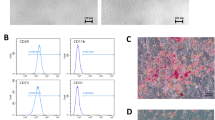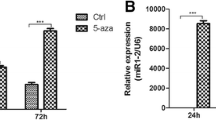Abstract
hUCMSCs were isolated and purified from the umbilical cords of normal or cesarean term deliveries under sterile conditions. Flow cytometry analysis revealed that CD13, CD29, CD44, CD90, and CD105 were highly expressed on the surface of passage-3 hUCMSCs, but negative for CD31, CD34, CD45, and HLA-DR. Immunocytochemistry showed that 5-azacytidine (5-aza) could induce the cTnI expression of hUCMSCs. RT-PCR showed that a stable higher level expression of DLL4 and Notch1 gene in 5-aza-induced group was observed compared to that in the control group. There was a higher expression level in the induced group. Compared with control group, the expression levels of Notch1 were, respectively, increased 6.60, 7.36, 7.595, and 7.805 times at 1, 3, 5, and 7 days after intervention of 5-aza. Statistically higher Ct value of Notch1 mRNA in induced group was observed in comparison with that of the control group (0.51 ± 0.21 vs 7.85 ± 0.35, t = 35.98, P < 0.01). The expression level of DLL4 increased stably compared with the control group. Compared with control group, the expression levels of DLL4 were, respectively, increased 11.53, 10.1, 10.17, and 11.46 times at 1, 3, 5, and 7 days after intervention of 5-aza. There was a significant difference of DLL4 Ct value between the 5-aza-induced group and the control group (1.60 ± 0.49 vs 12.42 ± 0.73, t = 11.71, P < 0.01). In conclusion, hUCMSCs can be differentiated into myocardial cells in vitro. The DLL4–Notch signaling pathway may be involved in the differentiation of hUCMSCs into cardiomyocytes induced by 5-aza.



Similar content being viewed by others
References
Si, Y. L., Zhao, Y. L., Hao, H. J., Fu, X. B., & Han, W. D. (2011). MSCs: biological characteristics, clinical applications and their outstanding concerns. Ageing Research Reviews, 10, 93–103.
Yang, S., Huang, S., Feng, C., & Fu, X. (2012). Umbilical cord-derived mesenchymal stem cells: strategies, challenges, and potential for cutaneous regeneration. Frontiers of Medicine, 6, 41–47.
Fukuda, K. (2002). Molecular characterization of regenerated cardiomyocytes derived from adult mesenchymal stem cells. Congenital Anomalies, 42, 1–9.
Xu, W., Zhang, X., Qian, H., Zhu, W., Sun, X., Hu, J., et al. (2004). Mesenchymal stem cells from adult human bone marrow differentiate into a cardiomyocyte phenotype in vitro. Experimental Biology and Medicine, 229, 623–631.
Cheng, F., Zou, P., Yang, H., Yu, Z., & Zhong, Z. (2003). Induced differentiation of human cord blood mesenchymal stem/progenitor cells into cardiomyocyte-like cells in vitro. Journal of Huazhong University of Science and Technology Medical Sciences, 23, 154–157.
Delalat, B., Pourfathollah, A. A., Soleimani, M., Mozdarani, H., Ghaemi, S. R., Movassaghpour, A. A., et al. (2009). Isolation and ex vivo expansion of human umbilical cord blood-derived CD34 + stem cells and their co transplantation with or without mesenchymal stem cells. Hematology, 14, 125–132.
Wu, C. X., Zhang, E. Y., Yang, S. Y., Ma, J. Y., An, Q., & Shi, Y. K. (2008). The Expression of GATA-4 and Nkx2. 5 Gene in the Transformation of Rattus Mesenchymal Stem Cells into Cardiomyocytes. Sichuan Da Xue Xue Bao Yi Xue Ban, 39, 825–882.
Méndez-Ferrer, S., Michurina, T. V., Ferraro, F., Mazloom, A. R., Macarthur, B. D., Lira, S. A., et al. (2010). Mesenchymal and haematopoietic stem cells form a unique bone marrow niche. Nature, 466, 829–834.
Chabannes, D., Hill, M., Merieau, E., Rossignol, J., Brion, R., Soulillou, J. P., et al. (2007). A role for heme oxygenase-1 in the immunosuppressive effect of adult rat and human mesenchymal stem cells. Blood, 110, 3691–3694.
Cho, J., Rameshwar, P., & Sadoshima, J. (2009). Distinct roles of glycogen synthase kinase (GSK)-3alpha and GSK-3beta in mediating cardiomyocyte differentiation in murine bone marrow-derived mesenchymal stem cells. Journal of Biological Chemistry, 284, 36647–36658.
Carolina, N., Perdigoto, & Allison, J. (2013). Bardin Sending the right signal: Notch and stem cells. Biochimica et Biophysica Acta, 1830, 2322–2370.
Author information
Authors and Affiliations
Corresponding author
Rights and permissions
About this article
Cite this article
Zhu, L., Ruan, Z., Yin, Y. et al. Expression and Significance of DLL4-–Notch Signaling Pathway in the Differentiation of Human Umbilical Cord Derived Mesenchymal Stem Cells into Cardiomyocytes Induced by 5-Azacytidine. Cell Biochem Biophys 71, 249–253 (2015). https://doi.org/10.1007/s12013-014-0191-2
Published:
Issue Date:
DOI: https://doi.org/10.1007/s12013-014-0191-2




